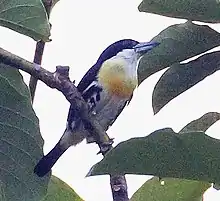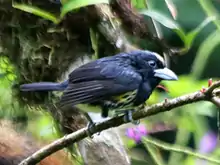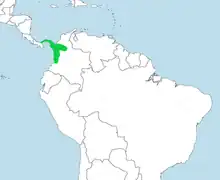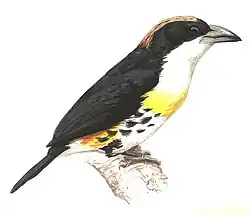Spot-crowned barbet
The spot-crowned barbet (Capito maculicoronatus) is a species of bird in the family Capitonidae. It is found in Colombia and Panama.[2]
| Spot-crowned barbet | |
|---|---|
 | |
 | |
| Male and female | |
| Scientific classification | |
| Domain: | Eukaryota |
| Kingdom: | Animalia |
| Phylum: | Chordata |
| Clade: | Dinosauria |
| Class: | Aves |
| Order: | Piciformes |
| Family: | Capitonidae |
| Genus: | Capito |
| Species: | C. maculicoronatus |
| Binomial name | |
| Capito maculicoronatus Lawrence, 1861 | |
 | |
Taxonomy and systematics
The spot-crowned barbet has two recognized subspecies, the nominate Capito maculicoronatus maculicoronatus and C. m. rubrilateralis.[2] Two additional subspecies, C. m. pirrensis and C. m. melas, have been proposed but "appear indistinguishable from rubrilateralis".[3] The spot-crowned barbet and the orange-fronted barbet (C. squamatus) are sister species and may form a superspecies.[3][4]

Description
The spot-crowned barbet is 16 to 18 cm (6.3 to 7.1 in) long and weighs 44 to 66 g (1.6 to 2.3 oz). The nominate male is mostly black above with a crown having brown-white spots. Its throat is white, its upper breast yellow to orange, and the lower breast and belly white with black spots. It has a splash of yellow to orange on the flanks. The female differs by having a black throat and upper breast. C. m. rubrilateralis has more white on its crown and its flank mark is orange to red.[3]
Distribution and habitat
The nominate subspecies of spot-crowned barbet is found from Panama's Veraguas Province east to the Canal Zone. C. m. rubrilateralis is found from eastern Panama into Colombia, east to Antioquia Department and south to Valle Department. It usually inhabits wet primary forest in both lowands and hill country and is also found in secondary forest. It is mostly found at elevations between 600 and 900 m (2,000 and 3,000 ft) but up to 1,200 m (3,900 ft) in a few areas.[3]
Behavior
Feeding
The spot-crowned barbet forages from mid level to the forest canopy for fruits, berries, and insects. It occasionally forages in small groups, and up to 10 have been recorded in fruiting trees. It is known to follow army ant swarms.[3]
Breeding
Observations of adult spot-crowned barbets in breeding condition, of nest excavation, and of fledglings appear to indicate a breeding season between December and late spring. One nest was attended by a male and two females.[3]
Vocalization
The spot-crowned barbet's principal vocalization is " a series of harsh “kkaaak” notes, gradually shifting to “kkkaakkk” sounds; it has been described as both a song and a call .[3]
Status
The IUCN has assessed the spot-crowned barbet as being of Least Concern.[1] It is uncommon to fairly common throughout its range.[3]
References
- BirdLife International (2020). "Capito maculicoronatus". IUCN Red List of Threatened Species. 2020: e.T22681908A163576047. doi:10.2305/IUCN.UK.2020-3.RLTS.T22681908A163576047.en. Retrieved 14 September 2023.
- Gill, F.; Donsker, D.; Rasmussen, P. (January 2021). "IOC World Bird List (v 11.1)". Retrieved January 14, 2021.
- Short, L.L., J. F. M. Horne, and A. Bonan (2020). Spot-crowned Barbet (Capito maculicoronatus), version 1.0. In Birds of the World (J. del Hoyo, A. Elliott, J. Sargatal, D. A. Christie, and E. de Juana, Editors). Cornell Lab of Ornithology, Ithaca, NY, USA. https://doi.org/10.2173/bow.spcbar1.01 retrieved May 25, 2021
- Remsen, J. V., Jr., J. I. Areta, E. Bonaccorso, S. Claramunt, A. Jaramillo, D. F. Lane, J. F. Pacheco, M. B. Robbins, F. G. Stiles, and K. J. Zimmer. Version 23 May 2021. A classification of the bird species of South America. American Ornithological Society. https://www.museum.lsu.edu/~Remsen/SACCBaseline.htm retrieved May 24, 2021
